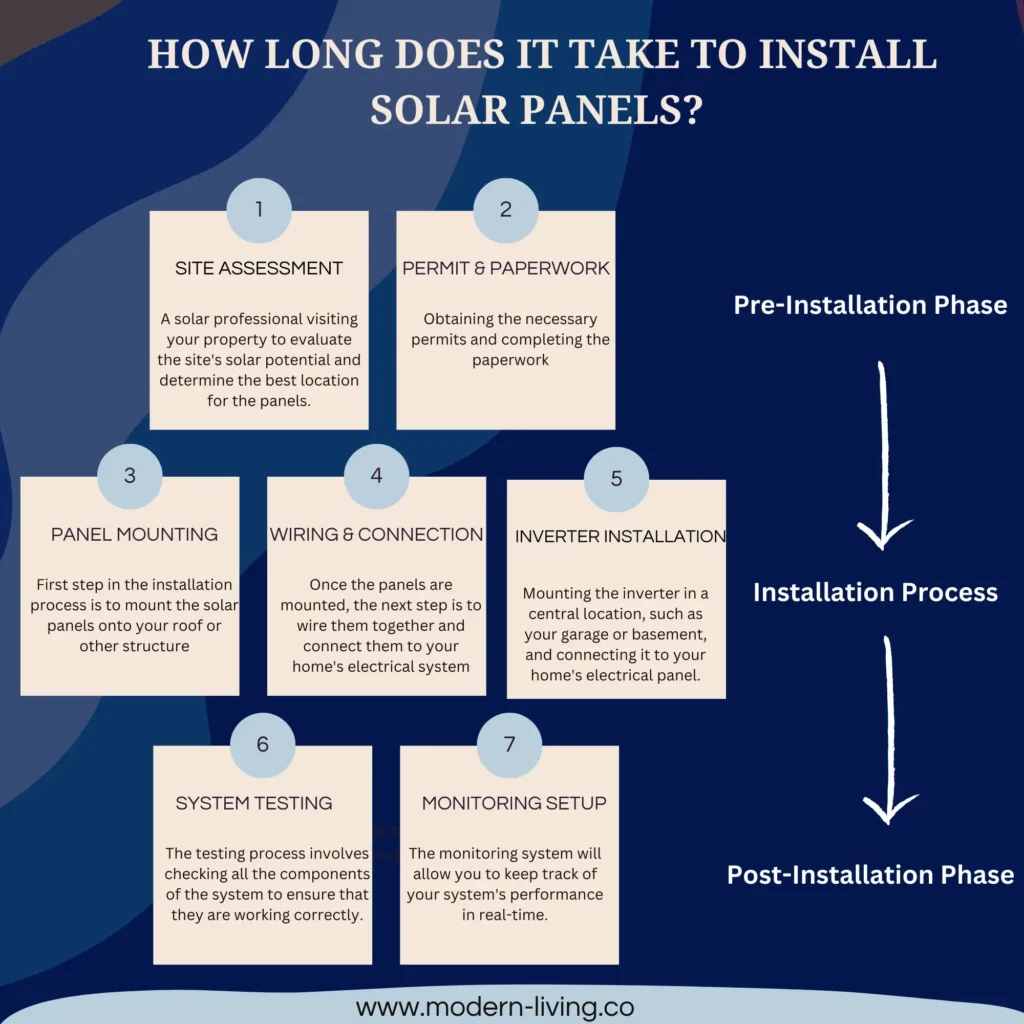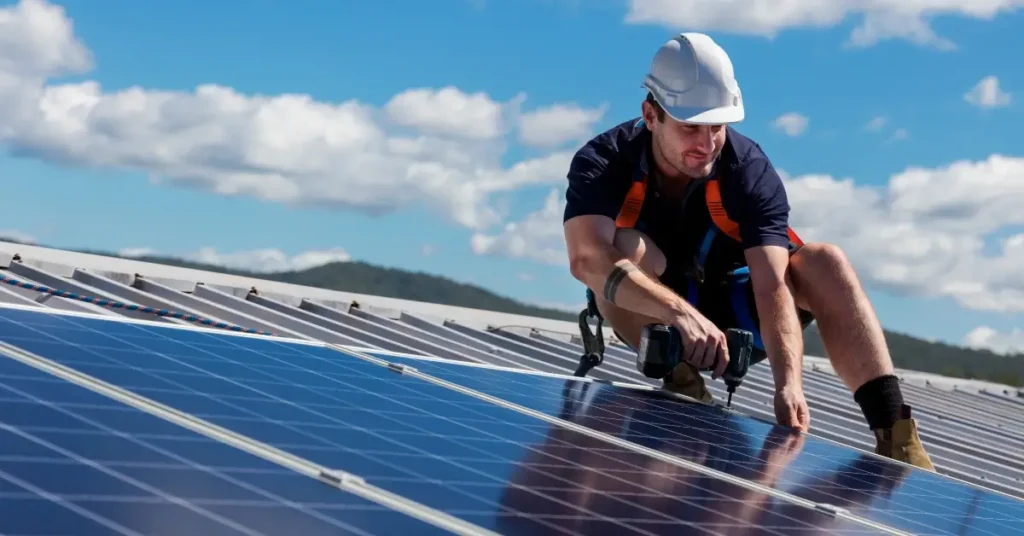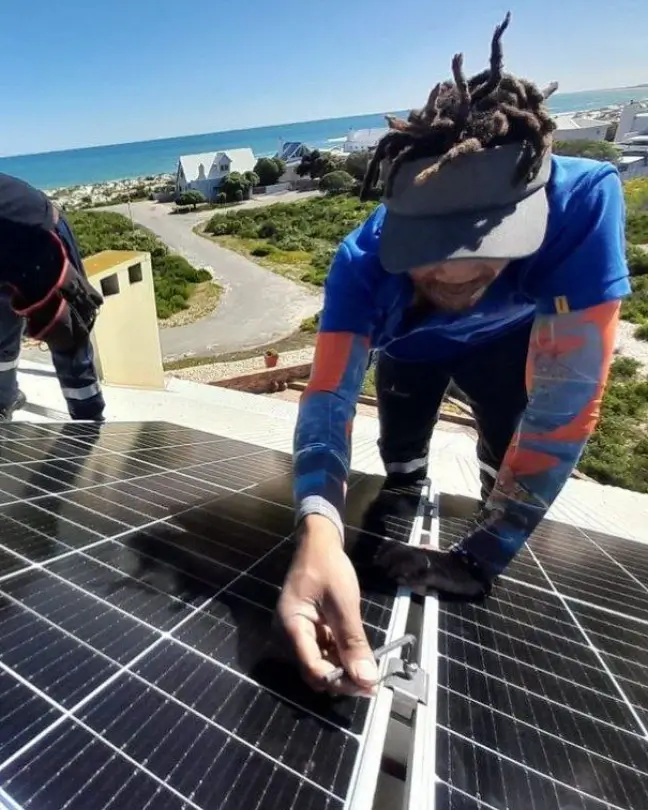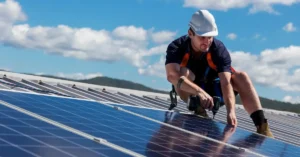Installing solar panels is a great way to reduce your carbon footprint and save on energy costs. But one question that many homeowners have is: How long does it take to install solar panels? The answer depends on a variety of factors, including the size of the system, the complexity of the installation, and the permitting process in your area.
Generally speaking, most residential solar panel installations can be completed in one to three days. However, if you’re installing a large commercial system, the installation process could take several weeks or even months. It’s important to work with a reputable solar company that can give you an accurate estimate of the timeline for your specific project.
The installation process for solar panels typically involves several steps, including a site assessment, design and engineering, permitting, and finally, installation and inspection. Each of these steps can take some time, so it’s important to be patient and work with your solar company to ensure that everything is done correctly. With the right team on your side, you can enjoy the benefits of solar power in no time.
How long does it take to Install Solar Panels: Average Time to Install

How long does it take to install solar panels? The answer is that it depends on a variety of factors, including the size of your system, the complexity of the installation, and the availability of permits.
On average, most residential solar panel installations can be completed in one to three days, according to EnergySage Blog. However, if you’re installing a large commercial solar panel system, it can take anywhere from a week to a couple of months.
The actual installation process, where your solar panels are physically mounted on your roof, typically takes anywhere from 1-3 days, according to Solvoltaics. However, scheduling and completing the city inspection can add additional time to the installation process. Your city will need to inspect the setup to ensure it meets all codes and regulations.
The longest part of the installation process is waiting for permit approval, which has the potential to take almost two months to complete, according to SolarReviews. This is because the installation of solar panels requires a series of permits and approvals from various government agencies.
Pre-Installation Phase
Before installing solar panels, there are several steps that need to be completed. This pre-installation phase is crucial in ensuring a smooth installation process.
Site Assessment
The first step in the pre-installation phase is a site assessment. This involves a solar professional visiting your property to evaluate the site’s solar potential and determine the best location for the panels. During the site assessment, the professional will take measurements and assess the roof’s condition to ensure it can support the panels. They will also consider factors such as shading, orientation, and tilt angle to optimize the system’s performance. This process typically takes a few hours, depending on the size of the system.
Permit and Paperwork
The second step in the pre-installation phase is obtaining the necessary permits and completing the paperwork. This can be a time-consuming process, as it involves obtaining permits from the local government and utility company. The solar company will typically handle the paperwork, but it’s important to be aware of the timeline. The permitting process can take anywhere from a few weeks to a few months, depending on the location and complexity of the project.
Installation Process

When it comes to installing solar panels, there are a few steps that need to be taken in order to ensure a successful installation. In this section, I will go over the three main steps involved in the installation process: Panel Mounting, Wiring and Connection, and Inverter Installation.
Panel Mounting
The first step in the installation process is to mount the solar panels onto your roof or other structure. This involves attaching the panels to a racking system that is designed to hold the panels securely in place. The racking system is then attached to your roof using a series of bolts and brackets that are designed to withstand high winds and other weather conditions.
Wiring and Connection
Once the panels are mounted, the next step is to wire them together and connect them to your home’s electrical system. This involves running wires from the panels to a central inverter, which converts the DC power produced by the panels into AC power that can be used by your home. The inverter is then connected to your home’s electrical panel, allowing the solar power to be distributed throughout your home.
Inverter Installation
The final step in the installation process is to install the inverter itself. This involves mounting the inverter in a central location, such as your garage or basement, and connecting it to your home’s electrical panel. The inverter is then programmed to work with your specific solar panel system, allowing it to convert the DC power produced by the panels into usable AC power.
Overall, the installation process for solar panels can take anywhere from a few weeks to several months, depending on a variety of factors such as the size of your system and the complexity of the installation. However, with the right team of professionals and a solid plan in place, you can enjoy the benefits of solar power in no time.
Post-Installation Phase
Congratulations! You have successfully installed solar panels on your property. Now, it’s time to move on to the post-installation phase. In this phase, we will ensure that your solar panel system is working correctly, and you are getting the most out of your investment.
System Testing
The first step in the post-installation phase is to test your solar panel system. The testing process involves checking all the components of the system to ensure that they are working correctly. During this process, we will check the wiring, inverters, and other components to ensure that they are connected correctly and functioning correctly.
After the initial testing, we will perform a series of tests to ensure that your solar panel system is generating the expected amount of power. We will also test the system’s performance during different weather conditions to ensure that it is working correctly in all environments.
Monitoring Setup
Once we have confirmed that your solar panel system is working correctly, we will set up a monitoring system. The monitoring system will allow you to keep track of your system’s performance in real-time. You will be able to see how much power your system is generating, how much energy you are using, and how much energy you are exporting to the grid.
The monitoring system will also alert you if there are any issues with your system. For example, if there is a fault with one of the components, the monitoring system will notify you immediately, allowing you to take action to resolve the issue quickly.
In conclusion, the post-installation phase is a crucial step in the solar panel installation process. It ensures that your system is working correctly and that you are getting the most out of your investment. By testing your system and setting up a monitoring system, you can rest assured that your solar panel system will continue to generate clean energy for years to come.
Factors Affecting Installation Time

When it comes to installing solar panels, several factors can influence the installation time. In this section, I will discuss the most important factors that can impact how long it takes to install solar panels.
Roof Type
The type of roof you have can affect the installation time of solar panels. If you have a flat roof, the installation process may be quicker than if you have a sloped or tiled roof. Flat roofs usually require less preparation and can be easier to work on. On the other hand, sloped or tiled roofs may require more time to install solar panels because of the additional work needed to ensure the panels are securely mounted.
Weather Conditions
Weather conditions can also play a role in how long it takes to install solar panels. If you live in an area with a lot of rain or snow, the installation process may take longer because the installers will need to wait for good weather conditions. Additionally, high winds can make it difficult to safely install solar panels.
Installer Experience
The experience of the solar panel installers can also affect the installation time. Experienced installers will be able to complete the installation process more efficiently than inexperienced installers. They will also be able to troubleshoot any issues that may arise during the installation process more quickly.
In conclusion, several factors can affect how long it takes to install solar panels. The type of roof, weather conditions, and installer experience are some of the most important factors to consider. By taking these factors into account, you can get a better idea of how long it will take to install solar panels on your home or business.
FAQ
Do solar panels work immediately?
Solar panels start working immediately but may take some time to reach their maximum efficiency. As soon as sunlight hits the panels, they begin generating electricity. However, it may take a few minutes for the panels to warm up and reach their optimal operating temperature.
What happens at night if you have solar panels?
Solar panels do not generate electricity at night since there is no sunlight. However, if you have a battery backup system, the excess energy generated during the day can be stored and used at night. Otherwise, you will need to rely on grid electricity or other backup power sources.
Can I install a solar system myself?
Yes, you can install a solar system yourself, but it is not recommended unless you have experience and knowledge of electrical and roofing work. Improper installation can be dangerous and may void warranties. It is advisable to hire a professional installer to ensure safety and optimal performance.
If you liked this blog article about the topic: How Long Does It Take to Install Solar Panels, don’t forget to leave us a comment down below to tell us about your experience.
Feel free to also check out our other Articles from the category “Solar System“



